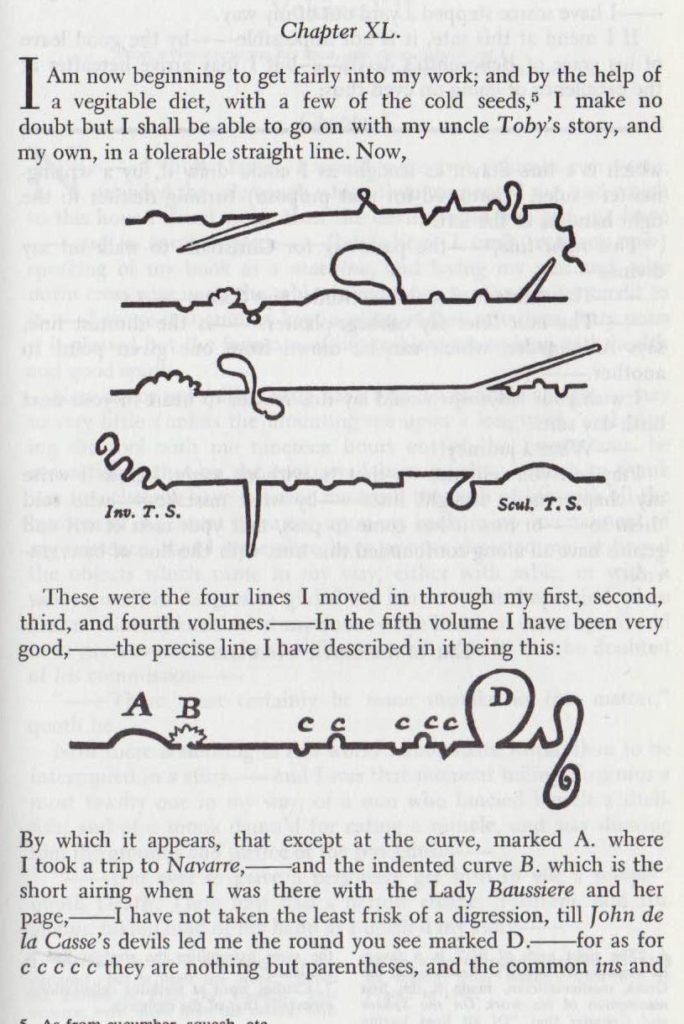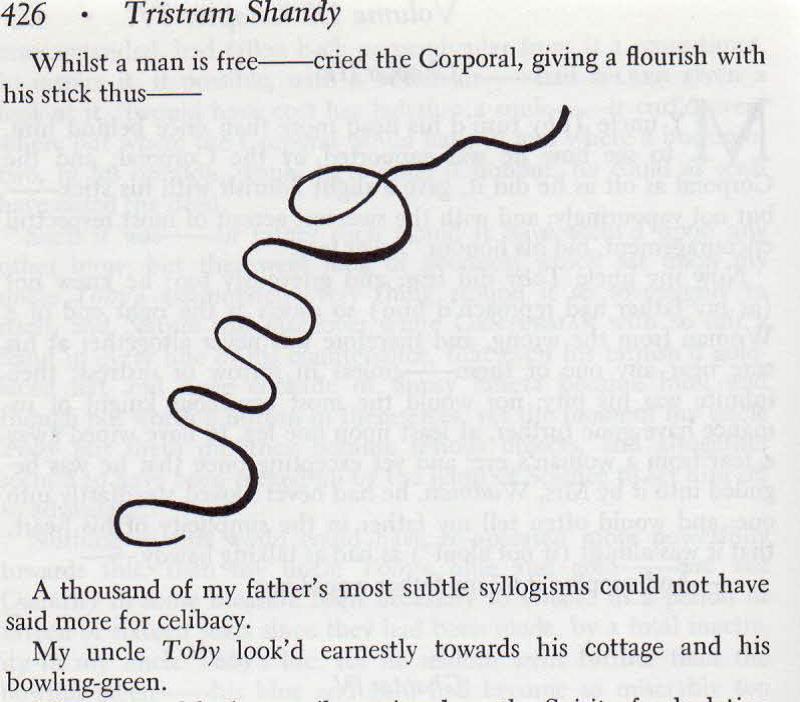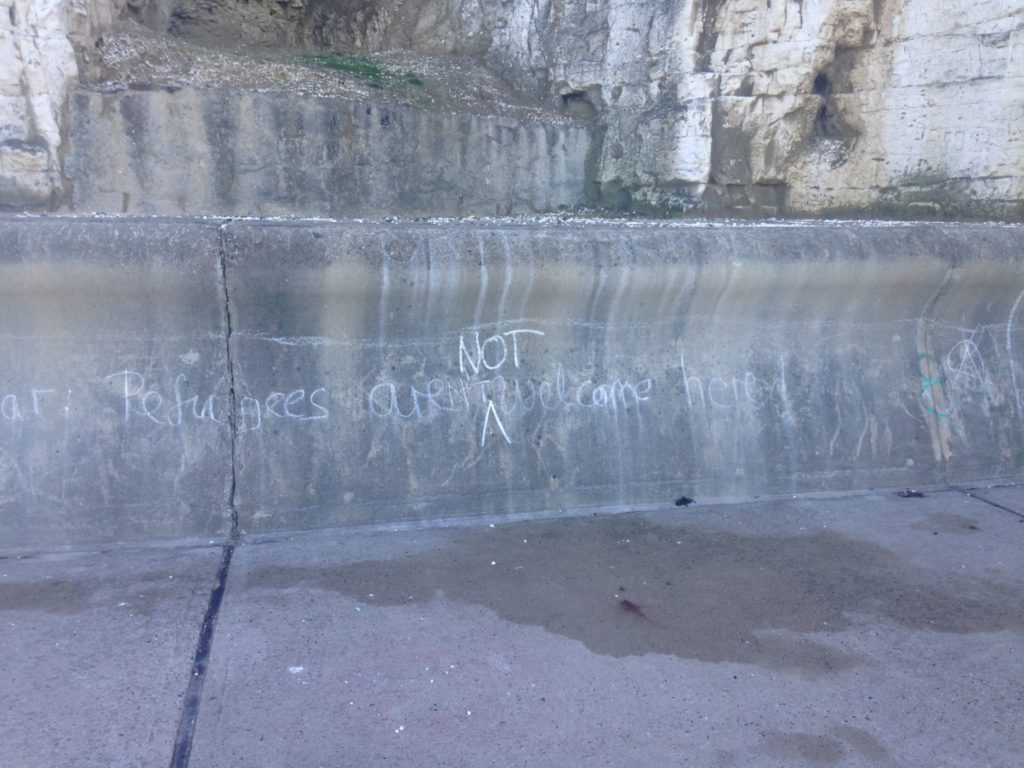Two images stick in my mind from my time as an undergraduate studying English literature thirty years ago (before I “converted,” so to speak, to religious studies). Both involve lines. The first is the memory of watching a lecturer drawing a thick chalk line on the blackboard—and then, in a mad teacherly flourish, adding crosses so that it looked like an impenetrable barbed-wire fence. I do not remember which particular moment this was meant to represent. It may have been during a lecture on the Renaissance, or on seventeenth-century metaphysical poetry. But the point was that this was the moment when access to the heavens and transcendence was closed off, as the thick line of separation came down.
The second set of lines were the wild, improvised lines in Laurence Sterne’s The Life and Opinions of Tristram Shandy, Gentleman (1759–67), that irreverent, bawdy, mock-autobiography by an Anglican clergyman, presumably written decades or even centuries after the lecturer’s heaven-earth apartheid line came down. I loved Sterne’s embarrassed record of the accidental-deliberate deviations that bulged out beyond the neat story line.

I remember laughing out loud at the gorgeous snaking line that attempted to record (like a pedantic anthropologist) the precise flourish of Corporal Trim’s stick as it gestured toward “freedom.”

(I would later discover that the wild line of Trim’s stick had also struck the social anthropologist Tim Ingold, who used it as an emblem for his project “Explorations in the Comparative Anthropology of the Line,” on the relations between walking, observing, and writing, or movement, knowledge, and description.) These contingent wayward lines became something of a figure for some of the directions taken in my own work. I have spent decades writing on the wayward, beautiful, and accidental interpretative movements that premodern interpreters and performers create around a single line of tradition—so distorting neat projections of premodern piety as following the party line. Sterne’s strangely contemporary (I would have said then, “postmodern”) eighteenth-century novel also became an early emblem for another shaping theme of my work: the scrambling of “the times.”
Back in the late 1980s I was a shy undergraduate. But I could not help but blurt out my question: What did the lecturer really mean? Did he really mean that at that moment, transcendence was shut off, the heavens closed for business? Did he really mean that now, after this moment, this this would be all there is/was? Or was this neat line one of those simplifications for undergraduates? It turned out that it was not. Never quite forgetting that chalkboard demonstration back in the 1980s, I have been fascinated by the faith and boast of secularization and the desire for that line. Like Eviatar Zerubavel in his wonderful book Time Maps, I have paid attention to how the question of “What time is it?” so often results in a line, imagined as a historical Rubicon, “the hinges on which the door of history swings.” I have watched academics from a range of disciplines draw their thick black lines between this and that, then and now—shifting the point of no return to the left or right (the English Civil War? 1688? 1765? 1789?). I have also watched them experience a growing sense of embarrassment and doubt around this easy game of halves, this (too) simple line.
The drawing of the line begs the counter-gesture: the crossing or rubbing out. We are over the line. We are now in the time after the time where it was possible to draw such simple lines. Perhaps one of the reasons why Charles Taylor’s A Secular Age became such an important text was because it so expansively demonstrated this double move: the affirmation of the line and the desire to breach it and then draw it again, but differently. Despite all the careful exposés of historical, sociological, and philosophical inaccuracy, we cannot resist the temptation of the line. And we seem to love the line for its confidence and fragility.
Visually, the line is so much more than a line. It defines form, creates structure, divides a frame, traces contour, creates tonal variation, and identifies edges (cf. W. J. T. Mitchell). Similarly, in speech, the simple line opens into a dense network of phrases, including holding the line, drawing the line (at), crossing the line, bringing into line, towing the line, and reading between the lines. As if marking its affective, emotional power, the line takes on cohortative, exhortative, and imperative moods. “We must draw a line somewhere.” “A line must be drawn.” No one says that a circle must be drawn.
Certain commonplace words and phrases operate like little conceptual drawers for storing, in shorthand, difficulties to which academics devote book-length studies or articles on The Immanent Frame. The anxious and conflicted senses of the deceptively simple phrase “drawing the line” condense—as popular wisdom—some of the difficulties that contributors to TIF have been analyzing for the last decade. Here is a definition with examples lifted straight from an online dictionary:
To draw the line
To separate one thing from another
“It’s not clear where this author draws the line between fact and fiction.”
“. . . at what point do we consider the fetus a baby? We’ve got to draw the line somewhere.”To decide firmly an arbitrary boundary between two things
“Where do you draw the line between your own decisions and those of your superiors?”To decide firmly the limit of what one will tolerate or participate in:
“The officer committed fraud but drew the line at blackmail.”To set a limit at something; to decide when a limit has been reached.
To decide firmly on an arbitrary boundary. To decide on the undecideable. Drawing the line suggests the volatility of decision combined with the necessity of decision: the groundless but necessary decision that has no stability except for “the line.” Drawing the line is about more than simple contrast or distinction. All the examples selected are deeply contentious. Fact and fiction, baby and fetus, submission to authority and justified disobedience. . . . The writer chooses controversies that have been closely associated with religion—far from accidentally I feel. (Dis)obedience to authority; truth (myth v. science); and the origins of life qua human life are precisely the kinds of issues that have orientated our stories about needing to draw the line between our (modern) space and the space of the wrong kind of “religion,” now conceptually boxed and packaged as “religion.” Perhaps we have been so drawn to drawing and contesting lines between “religion” and the “secular” because this now-classic fight condenses, in shorthand, so many other distinctions and decisions that are equally intractable and imprecise.
This means that the question of religion’s framing/sequestering, and its return, continues to be important, because religion has become the summary term for so many misfit concepts and phenomena that many seek to push to the other side of “the line.” It also means that we should be very cautious, because the now well-worn conflict between “religion” and the “secular” can be an obfuscation or alibi. The very ideas of the “religious” and the “secular”—and all the lines and frames and borders that we have built up and breached around them—need to be examined in all their obfuscations and material forms. The alleged line dividing the heavens from the earth, the “church” from the “state,” “religion” from “politics,” is made manifest in—and is also a gross simplification of—contemporary reappearances of “the line.”
We need to pay careful attention to these resurgent lines, which are coming thick and fast. Here are two examples. The first is from Régis Debray and Didier Leschi’s Everyday Laïcité: A Practical Guide, written in response to the terrorist attacks in France in 2015. The book is like a tiny updated Voltaire’s Dictionary, orientated around the central problem of religion. The entries run from “aumônerie” (chaplaincy) through to “zèle (excès de),” passing through “circumcision,” “caricature,” “headscarf,” “injury and blasphemy,” and “politics and faith” on the way. The entry on “caricature” is full of lines:
CARICATURE . . . Le dessin satirique représente à la fois la première ligne de front d’un régime de laïcité et, au plan international, une veritable ligne de partage entre les États qu’on peut dire laïques et les autres qu’on peut appeler cléricaux . . . Partout où le pouvoir politique s’affirme comme un pouvoir spirituel, le caricaturiste est bâilloné.1“Satirical drawings represent at one and the same time, the front line of the regime of laïcité, and, in the international arena, a true line of separation between states that we could call laïque, and states that we could term clerical. Wherever political power is asserted as a spiritual power, the caricaturist is gagged.”
In this complex mass of lines, we are called on to draw a clear line between those states that draw a line and those that do not; those with a line (between “church” and “state”) and those without (and also those that celebrate and those that censor and punish the caricaturists’ free, wild, irreverent lines). Debray and Leschi’s imagined line between a line and linelessness seems to fantasize the exorcism of the spiritual from politics. (One day all states will have the line.) It seems to dream of a vanishing point: the point at which the spiritual vanishes over the horizon line and is exorcised from the political, at some future point in time.
Lines in time are lines in space. Like lines of latitude and longitude, they distinguish between different timelines of different parts of the globe. They shade into borders and “front lines.” (I think of border lines: some so straight that you can see the colonial geographer’s ruler; some tortured, like the bloody “partition” lines drawn on “religious” grounds between Palestine and Israel and India and Pakistan. I think, ironically, that you can find a darker version of the bulging contingent wayward line in Tristram Shandy in the bloody histories and detours of these partition lines.) Debray and Leschi’s imagined line is a “front line”: a strangely antiquated, even nostalgic, concept—far better suited to the times of Franco-Prussian War or the First or Second World Wars than to 2015. The line envisaged by Debray and Leschi is a thick black line—but it is also faint and fragile. The line conscripts us to its defence. A front line is a line that is besieged.
The second example of resurgent lines also drew on the pathos of the line that is both strong and very weak. Inspired, no doubt, by the new rage for very public walls—Viktor Orbán’s razor-wire fence; Donald Trump’s wall (with or without solar panels); the Great Wall of Calais—citizens in the UK began improvising pop-up walls during the run up to the Brexit referendum. Cycling along the North Kent coast, I saw that, in a different way than my former lecturer, some of my fellow citizens had been fantasizing their own lines in concrete and chalk. Someone had scrawled on the sea wall a far ruder version of the immigration managers’ preference for AVRR (= Assisted Voluntary Return and Reintegration = sending them home). Someone else had written, “Refugees are welcome”—and then someone else (or maybe the first border-maker) had inserted “not.”

Though no boats actually dock in Margate, the thick concrete sea wall lent itself to fantasies of an imagined (old-style) border. Like Debray and Leschi’s line, the chalk declaration carried connotations of “A line must be drawn—finally.” It had the strong affective force of a line that is strong, and that is weak. “We are strong; we have (or we will recapture) the power to draw this line. And/but also we must draw the line, because we are emptied out; they have taken our resources by flooding in.” These strong-weak lines clearly have considerable power to move. People crave their certainty and/but are also moved by their fragility to leap to their defense.
The fantasy of the borderline that could be drawn—or not—showed just how usefully oblivious most citizens are to complex systems of migration management. These now work just like systems of coastal management, with carefully calibrated, and constantly changing, techniques for managing incoming and variable “tides.” Over the last thirty years—in fact, from around the time I first saw that chalk line come down between the earth and the heavens—borders have become less like walls or doors and more like filtration systems or membranes. A long way from literal shores, and in indefinite detention centers in the hinterlands of our airports (often out by the barbed-wire fences at the perimeter), extragovernmental organizations like Frontex are tasked with producing “economically needed and beneficial flows” of human/economic resource. They have created tick-box frames and boxes to categorize classes and values of the migrant, and have progressively criminalized the very idea of seeking to cross the line/border, long before any border is actually reached. Like and unlike the line between the religious and the secular, the border is hard, and it is soft; it is drawn, and it is breached.
The old line between the “religious” and the “secular” is becoming a fact on the ground at our (displaced) borders—but it can also be used to mask what is happening, deflecting questions about space to questions about the “public sphere.” We need to pay particular attention to the uses of the vexed line (that does not know whether it is a dividing slash or a hyphen) between “religion” and “race” and the ways in which questions of “religion” can be used to mask racial prejudice. As long as we talk only in terms of the freedom of the caricaturists and the fundamental freedom to hold the (secularization) line, we can avoid the ugly facts of profound restrictions on freedom of movement and European racisms. It is never simply a matter of holding the secularization line and drawing our lines however we please.












